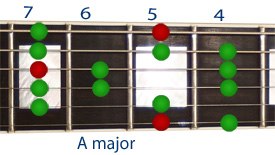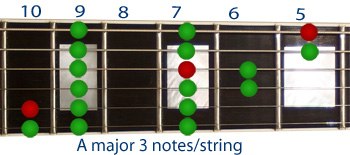Theoretically speaking...
I'm not going to go too deep here, however there is certainly some theory which will be a great help to development, e.g, chord shapes, some scales, harmony, etc... It can be fun to try and work out how Brian May or Thin Lizzy came up with their harmony guitar lines...
You can clearly play guitar without knowing any theory at all, many famous and not so famous guitarists do just that. You don't have to know 'what' you're playing to know it sounds good, over the years you will learn chord and scale shapes that you just know work well together.
I'm no music theory expert by any means, but even a little theory can go a long way, help you understand why what you play sounds good, and trigger new ideas for experimentation. This is just my take on it, hope it helps...
Frets=Notes
As you move up the frets on any guitar string you are raising the pitch of the note by a semi-tone per fret..
There are 12 distinct pitches in western music, so on the guitar these start again every 12 frets but an Octave higher. ('Oct', like in Octagon, means 8 and derives from the Major scale having 7 notes as we'll see later. The 8th note meaning your back to the start, just higher, an octave higher!))
So when referring to pitch changes in music we talk about "semi-tones", or "whole-tones", a Whole Tone equating to two frets on the guitar.
Taking the low E on the guitar (String 6), the open note is obviously E, for the first 12 notes we have:
E, F, F#, G, Ab, A, Bb, B, C, C#, D, Eb
then they repeat starting from the 12th fret.
Listen to an open string note and then the 12th fret note of any string and you will notice that even though the 12th fret pitch is higher they have the same quality, they are in fact the same note just an octave apart. The reason for this matching quality is that the 12th fret is positioned at exactly half the length of the string. This is also the pitch of the 2nd natural harmonic of that string, that is why you can lightly touch the string at the 12th fret and get that bell like pure harmonic sound. But more on harmonics later....
The Major Scale
This has to be the first and most important thing to learn as it can be used as the reference point for further understanding.
The white notes on a piano are the C Major scale(C, D, E, F, G, A, B). The famous Do, Re, Mi, Fa, So, La, Ti, Do is also the Major scale.
We can define a Major scale by looking at the pitch difference, the interval, between the notes making up the scale. Going back to the the Whole-Tones/Semi-Tones I mentioned earlier, then the intervals to play a major scale are:
T-T-S-T-T-T-S
T = Whole-Tone = 2 Frets
S = Semi-Tone = 1 Fret
So to play a C Major scale that starts with the C found at the 3rd fret of the 5th string we play the frets:
3-5-7-8-10-12-14-15
-T-T-S-T--T--T--S
To play a different key you simply start at the desired not and apply the same formula, so for A major on the 6th string we get
5-7-9-10-12-14-16-17
-T-T-S--T--T--T--S
On the guitar you wouldn’t normally play this on a single string only so to play the scale in one place across all strings we get what will become a familiar pattern for a major scale covering 2 octaves:
RED = Root note
i.e., the Key of the
scale.
To play the major scale in any other key simply shift the pattern up and down the neck so the root note is the key you want, e.g., for B major move this pattern up two frets so starting on the 7th fret B note.
As familiar as this pattern is it’s not the easiest to let rip and improvise with, another popular pattern for a major scale introduces the 3 Notes/String concept. Almost any scale can be played this way and it lends itself to fast runs and is widely used for legato playing by guitarist such as Joe Satriani.
A major becomes:
We can now use this scale to define other chords and scales. But first we need to number each note of this scale from 1 to 7, with the 1st note also being known as the Root note. Now we can use these numbers as formulas:
For C Major the notes are
1=C
2=D
3=E
4=F
5=G
6=A
7=B
The formula for a major chord is 1, 3, 5, so to play C Major we take the 1st, 3rd, and 5th notes fro the major scale. This gives us C, E, G
The formula for a minor chord is 1, 3b, 5, i.e., we just flatten the 3rd by one semitone, so for "C minor" we get C, Eb, G
More, and better organisation, to come....


